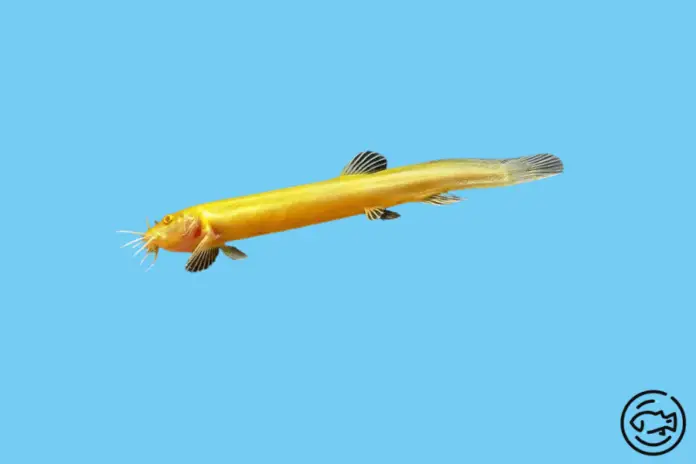The Golden Loach, also known as the Chinese sucker, is a member of the carp family. It is a native of East Asia and is found in China, Japan, Korea, and Vietnam.
The golden loach has a long, slender body and can grow up to 18 inches (45 cm) long. It is brown or gold, with dark spots on its sides.
They are a prevalent aquarium fish and are kept by hobbyists around the world.
They are a peaceful breed that does well in a community aquarium. It prefers to live in groups and will do best when kept with other peaceful fish of similar size.
The golden loach is an active swimmer and will do best in an aquarium with plenty of open space to swim, and it is also a good algae eater which will help keep your aquarium clean.
They are not a demanding fish but prefers water with a moderate flow. The ideal temperature range for this fish is 68-75° Fahrenheit (20-24°Celsius).
The pH should be slightly acidic to neutral, around 6.5-7.5. They are not picky eaters and will accept most aquarium foods.
Habitat
The golden loach is found in calm, slow-flowing rivers throughout Europe. It generally prefers habitats with sandy or pebbly bottoms but can also be found in areas with soft mud substrates.
Lifecycle
The Golden Loach’s life cycle is slightly different from other fish species.
Instead of hatching their young, they lay eggs in plants and then care for them until they are old enough to fend for themselves. The parents will continue to protect their offspring even after they have left the nest.
This process takes about two months, and once the fry is ready to be on its own, it will disperse into different areas of the pond or lake. The fry grows quickly and can reach adulthood within a year.
These fish typically live for 5-10 years in captivity, but their lifespan in the wild is unknown.
Aggressiveness
The golden loach is not aggressive by nature. However, if they are not given enough space, they may become aggressive toward each other, especially if they are too big.
You can keep them with other fish without a problem as long they have enough space to move around.
Diet

Golden loaches are omnivorous and will eat plant and animal matter. Their diet consists of small invertebrates, worms, and other smaller fish in the wild. In captivity, they should be fed a diet that contains both plant and animal matter.
This can be achieved by feeding them high-quality commercial flake food and live or frozen foods like brine shrimp, bloodworms, and daphnia. Live plants can also be offered as part of their diet.
They are known to be avid diggers, so any live plants offered should be securely anchored in the substrate.
Breeding

Golden loach breeding is not an easy task as there are several things you need to take into consideration to have success.
First, you must ensure the water temperature is just right. The water should be around 68-72° F.
If it is too hot for the golden loaches or too cold, then they will not breed.
Second, you need to have a good filtration system in place. This is important because it will help keep the water clean and toxins-free.
Third, you must provide plenty of hiding places for the golden loaches. This can be done by using plants, rocks, or other objects in the aquarium.
Finally, it would be best if you fed the golden loaches a high-quality protein-rich diet. If you do all these things, you should be able to breed them successfully.
Also, when breeding golden loaches, it is best to use a spawning mop. This is because the loaches will lay their eggs on the mop, then the mop can be easily removed, and the eggs can be incubated in a separate tank.
If you do not have a spawning mop, you can also use java moss or another type of plant. The most important thing is to ensure plenty of hiding places for the fry (baby fish) once they hatch.
Otherwise, they will likely be eaten by their parents or other fish in the tank.
Parasites And Diseases
Many parasites and diseases can affect golden loach. Some of the more common ones include:
–Ichthyophthirius multifiliis (ich): This parasitic disease causes white spots on the fish. It is often fatal if left untreated.
-Protozoan infections: These are parasites that can cause a variety of symptoms, such as lethargy, loss of appetite, and weight loss. They can be fatal if left untreated.
-Viruses: Many viruses can affect golden loach, some of which are deadly. The most common virus is the golden loach iridovirus (GLIV), which is responsible for causing mass die-offs in wild populations.
-Bacterial infections: Bacterial infections often cause fin rot and other problems. They can be fatal if left untreated.
How To Prevent Diseases And Parasites
To help prevent parasites and diseases in your golden loach, you can try some things like:
Keep the tank clean
The tank should be cleaned regularly, at least once a week. This will help to remove any potential parasites or diseases that may be present.
Quarantine new fish
Before adding new fish to your tank, it is essential to quarantine them for at least two weeks. This will help to ensure that they are not carrying any parasites or diseases that could potentially infect your other fish.
Keep an eye on your fish
It is essential to maintain an eye on your fish daily as this will help you to spot any potential problems early on and take care of them before they become serious.
Get regular check-ups
Call your veterinarian for regular check-ups. They will be able to help you spot any potential problems and give you the best course of action to take.
Check for possible symptoms of parasites or diseases such as:
-Loss of appetite
-Weight loss
-Floating upside down
-Listlessness
-Gasping for air
-Frequent scratching or rubbing against objects in the tank
If you notice any of these symptoms, you must take your fish to the vet as soon as possible. The sooner you catch a problem, the easier it will be to treat.
Predators
Their predators include fish, amphibians, reptiles, and mammals. Fish that prey on golden loaches include catfish, pike, and carp.
Amphibians, such as frogs and newts, will also eat these fishes.
Snakes, turtles, and crocodiles are among the reptile predators of golden loaches. Mammals such as otters and raccoons will eat these loaches as well.
Tank Requirements

A golden loach tank can be a beautiful and peaceful addition to your home and is relatively easy to care for.
Here is a guide on how to set up a successful golden loach tank.
Tank Size
The golden loach requires an aquarium with at least 45 gallons of capacity.
The aquarium should have a sand or gravel substrate and plenty of hiding places. Plants are not necessary but can be added if desired.
Filtration
The foremost thing you require to do when setting up your tank is to install a good filtration system.
Golden loaches are messy eaters and produce a lot of waste, so you need a filter that will be able to handle the load. Using a canister filter or a wet/dry filter is recommended.
Water Quality
Since golden loaches are native to tropical climates, they prefer warm water. The temperature of the water must be maintained between 76-84°F.
Maintaining a high level of water quality in the tank is also essential. This can be done by regular water changes and using a good aquarium vacuum.
Use A Heater
Use a Heater to maintain the water temperature between 76-84 degrees Fahrenheit.
Substrate
When choosing a substrate for your golden loach tank, it is best to go with something dark in color.
This will help to bring out the colors of your fish.
Golden loaches also like to burrow, so choosing a substrate they can easily dig into – like gravel or sand are both excellent choices.
Plants
Golden loaches are not particularly picky with plants but prefer live plants over artificial ones.
They will also uproot plants not anchored down well, so be sure to choose plants with solid roots.
Some good plant choices for a golden loach tank include java ferns and hornwort.
Lighting
Since golden loaches are bottom dwellers, they do not require intense lighting. A simple fluorescent bulb will suffice.
Now that you understand how to set up a golden loach tank, you can enjoy these beautiful and peaceful fish in your own home.
Are Golden Loaches Good Pets?

Golden loaches are beautiful fish that make great pets. They are peaceful and can get along with other fish in a community tank.
They are active & love to play, and are also easy to care for, making them a good choice for beginner aquarium keepers.
They are hardy fish and can endure a broad range of water conditions.




hello i have your information on gold dojo loaches and it is very informative. i have a couple of questions. the 1st one is the water temperature. i was in the process of doing a partial water change, i thought i had my replacement water at the correct temperature. my babies become very slimy on their body, what or why would this happen. 2nd what is the slimy stuff that comes from my loaches when they poo. i so hope you can educate me on these 2 items. thank you so much
Trish
If your gold dojo loaches’ babies have become slimy on their bodies after a water change, it’s possible that the temperature of the replacement water was too different from the temperature of the original water in the tank. Abrupt changes in water temperature can cause stress to fish and other aquatic creatures, which can make them more susceptible to diseases and infections.
The slime on their bodies could be a result of the fish trying to protect themselves from the sudden changes in temperature, or it could be a symptom of a bacterial or fungal infection. It’s essential to monitor your fish closely and look for other signs of illness, such as lethargy, loss of appetite, or visible signs of lesions or discoloration.
To address the issue, you should first check the water temperature to ensure it is appropriate for the fish species you are keeping. You may even want to consider adding a water conditioner to remove any harmful substances that may be present in the replacement water. If you detect any indications of illness or infection, consider treating the tank with a suitable medication. You may want to seek advice from a veterinarian or fish expert for the best course of action.
The slimy stuff that comes from your loaches when they poo is most likely mucus, which is a protective coating that fish and other aquatic creatures produce. Mucus helps protect fish from parasites, bacteria, and other harmful substances in the water. It also helps to lubricate the digestive tract, making it easier for the fish to pass feces.